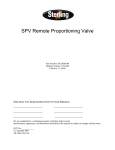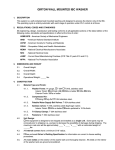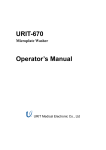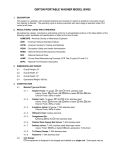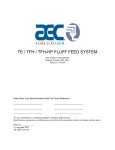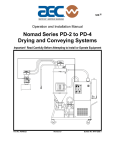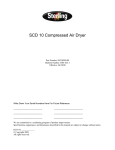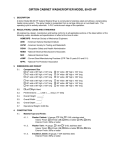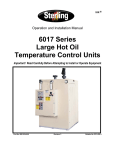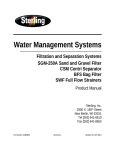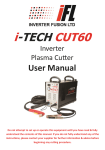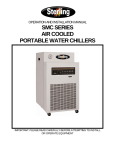Download RPV Remote Proportioning Valve
Transcript
RPV Remote Proportioning Valve Part Number: 882.00211.00 Bulletin Number: WH5-150.1 Effective: 4/10/08 Write Down Your Serial Numbers Here For Future Reference: _________________________ _________________________ _________________________ _________________________ _________________________ _________________________ We are committed to a continuing program of product improvement. Specifications, appearance, and dimensions described in this manual are subject to change without notice. DCN No. ____________ © Copyright 2008 All rights reserved. Shipping Info Unpacking and Inspection You should inspect your Remote Proportioning Valve for possible shipping damage. Thoroughly check the equipment for any damage that might have occurred in transit, such as broken or loose wiring and components, loose hardware and mounting screws, etc. In the Event of Shipping Damage According to the contract terms and conditions of the Carrier, the responsibility of the Shipper ends at the time and place of shipment. Notify the transportation company’s local agent if you discover damage. Hold the damaged goods and packing material for the examining agent’s inspection. Do not return any goods before the transportation company’s inspection and authorization. File a claim with the transportation company. Substantiate the claim by referring to the agent’s report. A certified copy of our invoice is available upon request. The original Bill of Lading is attached to our original invoice. If the shipment was prepaid, write us for a receipted transportation bill. Advise customer service regarding your wish for assistance and to obtain an RMA (return material authorization) number. If the Shipment is Not Complete Check the packing list as back-ordered items are noted on the packing list. You should have: ; Remote Proportioning Valve ; Bill of lading ; Packing list ; Operating and Installation packet ; Electrical schematic and panel layout drawings ; Component instruction manuals Re-inspect the container and packing material to see if you missed any smaller items during unpacking. If the Shipment is Not Correct If the shipment is not what you ordered, contact the parts and service department immediately at (847) 273-7700. Have the order number and item number available. Hold the items until you receive shipping instructions. Returns Do not return any damaged or incorrect items until you receive shipping instructions from the shipping department. WH5-150 ii Table of Contents CHAPTER 1: SAFETY................................................................ 5 1-1 1-2 1-3 How to Use This Manual ............................................................................................. 5 Safety Symbols Used in this Manual .....................................................................5 Responsibility .............................................................................................................. 5 Warnings and Precautions .......................................................................................... 6 CHAPTER 2: FUNCTIONAL DESCRIPTION ............................. 7 2-1 2-2 2-3 2-4 Models Covered in This Manual.................................................................................. 7 General Description..................................................................................................... 7 How it Works ............................................................................................................... 7 Typical Features and Components ............................................................................. 8 RPV-A ...................................................................................................................8 RPV- B and D ........................................................................................................8 RPV - C .................................................................................................................8 CHAPTER 3: INSTALLATION.................................................... 9 3-1 3-2 Mounting the RPV ....................................................................................................... 9 Wall Mount Installation ..........................................................................................9 Floor-Mount Installation .......................................................................................11 Machine-Mount Installation .................................................................................12 Installing the RPV Controls ....................................................................................... 13 Installing the RPV-A Autoload Knob Box Control ................................................13 Installing the RPV-B and RPV-D Standalone for Central Vacuum Systems .......15 Installing the RPV-C 9953 and 9963 Hopper Loader Control..............................17 CHAPTER 4: OPERATION....................................................... 18 4-1 4-2 4-3 4-4 Knob Box Operation .................................................................................................. 18 Ratio Knob...........................................................................................................18 Cycle Seconds Knob ...........................................................................................18 Power Switch and Indicator .................................................................................18 Standalone Control Operation................................................................................... 19 Power Switch.......................................................................................................19 Fuse Holder.........................................................................................................19 Conveying Time Range Selector Potentiometer .................................................19 Timer Dial Increment Selector Potentiometer......................................................19 Material A Timer ..................................................................................................19 Material B Timer ..................................................................................................19 Hopper Loader Conversion Operation ...................................................................... 20 Example 1 ...........................................................................................................20 Example 2 ...........................................................................................................20 Weight Test for Accurate Proportioning .................................................................... 21 CHAPTER 5: TROUBLESHOOTING ....................................... 22 5-1 WH5-150 Introduction................................................................................................................ 22 iii CHAPTER 6: APPENDIX.......................................................... 24 6-1 Technical Specifications............................................................................................ 24 Electrical Requirements ......................................................................................24 Compressed Air Consumption.............................................................................24 6-2 Drawings and Diagrams ............................................................................................ 25 RPV Dimensions .................................................................................................25 RPV Assembly Drawing and Parts Breakdown ...................................................26 -Notes- ................................................................................................................................. 27 6-3 Technical Assistance................................................................................................. 28 Parts Department ................................................................................................28 Service Department.............................................................................................28 Sales Department................................................................................................28 Contract Department ...........................................................................................28 WH5-150 iv Chapter 1: Safety 1-1 How to Use This Manual This manual covers only light corrective maintenance. No other maintenance should be undertaken without first contacting a service engineer. The Functional Description section outlines models covered, standard features, and safety features. Additional sections within the manual provide instructions for installation, specifications, and operation. The Installation chapter includes required data for receiving, unpacking, inspecting, and setup of your product. We can also provide the assistance of a factory-trained technician to help train your operator(s) for a nominal charge. Safety Symbols Used in this Manual The following safety alert symbols are used to alert you to potential personal injury hazards. Obey all safety messages that follow these symbols to avoid possible injury or death. 1-2 DANGER! DANGER indicates an imminently hazardous situation that, if not avoided, will result in death or serious injury. WARNING! WARNING indicates a potentially hazardous situation or practice that, if not avoided, could result in death or serious injury. Caution! CAUTION indicates a potentially hazardous situation or practice that, if not avoided, may result in minor or moderate injury or in property damage. Responsibility These machines are constructed for maximum operator safety when used under standard operating conditions and when recommended instructions are followed in the maintenance and operation of the machine. All personnel engaged in the use of the machine should become familiar with its operation as described in this manual. Proper operation of the machine promotes safety for the operator and all workers in its vicinity. Each individual must take responsibility for observing the prescribed safety rules as outlined. All caution, warning and danger signs must be observed and obeyed. All actual or potential danger areas must be reported to your immediate supervisor. WH5-150 Chapter 1: Safety 5 of 28 1-3 Warnings and Precautions STERLING water management systems products are designed to provide safe and reliable operation when installed and operated within design specifications, following national and local safety codes. To avoid possible personnel injury or equipment damage when installing, operating, or maintaining this equipment, use good judgment and follow these safe practices: ; Follow all SAFETY CODES. ; Wear SAFETY GLASSES and WORK GLOVES. ; Disconnect and/or lock out power before servicing or maintaining the system. ; Use care when LOADING, UNLOADING, RIGGING, or MOVING this equipment. ; Operate this equipment within design specifications. ; OPEN, TAG, and LOCK ALL DISCONNECTS before working on equipment. You should remove the fuses and carry them with you. ; Make sure that system equipment and components are properly GROUNDED before you switch on power. ; Do not jump or bypass any electrical safety control. ; Do not restore power until you remove all tools, test equipment, etc., and the system and related equipment are fully reassembled. ; Only PROPERLY TRAINED personnel familiar with the information in this manual should work on this equipment. WH5-150 Chapter 1: Safety 6 of 28 Chapter 2: Functional Description 2-1 Models Covered in This Manual This manual offers a general reference for the installation and operation of the Remote Proportioning Valve (RPV) with control configurations A, B, C, and D. Material inlets and outlet sizes range from 1.5” to 2.5”. 2-2 General Description The Remote Proportioning Valve is an efficient and economical means to proportion two different free-flowing granulated materials in a material conveying system. The most common application is mixing virgin and regrind materials in a plastic processing operation. The design of the Remote Proportioning Valve lends itself to use in both central and machine-side conveying systems. The RPV also can turn a standard hopper loader or anyone’s vacuum hopper into a proportioning unit. Mounting of a Remote Proportioning Valve can be at a convenient location away from the hopper or loader or on the material inlet tube of a vacuum hopper or hopper loader. Two urethane plungers operated by compressed air are positioned in a central vacuum chamber to provide airflow control between two separate material conveying lines. The operator controls the positioning of the plungers and dictates the percentage of the two materials to be delivered through a single hose to a material receiver. Plunger operation can be governed by a variety of control alternatives, depending on the installation. 2-3 How it Works The Remote Proportioning Valve proportions two free-flowing dry materials into a single vacuum conveyed stream. It can be mounted some distance from or directly on the vacuum receiver. Two material inlets lead into a central vacuum manifold. Compressed air operated plunger valves switch the vacuum supplied by a hopper loader or central system between two material pick-up devices. Switching between the inlets at timed intervals creates a known mixture of virgin and regrind materials. The mixture can have a minimum accuracy of 5%, depending on how controlled the set-up of the Remote Proportioning Valve is. The controls are set up on a timing cycle. The Material A plunger is opened to the vacuum stream for an adjustable period of time, and then closes. The Material B plunger opens immediately and conveys the second material for an adjustable period of time. By adjusting these intervals, the proportioning is controlled. Under ideal conditions with identical total resistance in both material hoses and the Material A and B timers set at 10 and 5 seconds respectively, a 2-to-1 mixture is delivered to the vacuum receiver. Under actual conditions, total resistances will not be identical. Two materials with different conveying characteristics, such as regrind and virgin, conveyed from differing pickup devices over differing distances, are not be conveyed at the same rate. To ensure a mixture of known proportions, a weight test as described in Section 4-4 on page 21 should be performed for each application. WH5-150 Chapter 2: Functional Description 7 of 28 2-4 Typical Features and Components The RPV is available with a variety of control choices designed to suit your particular operation. RPV-A The A model Remote Proportioning Valve is designed exclusively for use with the Autoload Hopper Loader. RPV- B and D The B and D model RPV’s are designed for use with central vacuum systems. These models will convert any existing vacuum hopper into a proportioning unit, regardless of manufacturer. The RPV – B uses 110 VAC supply voltage. The RPV – D is designed to be used outside of North America with 220 VAC supply voltage. RPV - C The RPV-C model is designed to convert existing 9953 and 9963 Hopper Loaders into proportioning units. WH5-150 Chapter 2: Functional Description 8 of 28 Chapter 3: Installation 3-1 Mounting the RPV The RPV can be mounted to a machine, on the floor, or on a wall. The optional floor stand provides installation location flexibility. The RPV can be used with more than one machine by switching hoses and positioning the floor mounted RPV in a convenient place. Wall Mount Installation This type of installation uses the optional wall mounting bracket to mount the Remote Proportioning Valve to a convenient wall, pipe, or other structural member. Use the following procedure to install the RPV using the wall-mount configuration: (See Figure 1 for more information.) 1. Select a location for the RPV that allows access to the clean-out and viewing hatch. Plan ahead for a spot where the two material supply hoses and the material delivery hose do not interfere with your workspace or create a tripping hazard. 2. Secure the wall bracket to a suitable wall, beam, etc. that can support 250 lbs. of weight hanging from it. 3. Prepare the RPV for installation by removing the four bolts that attach the single outlet tube to the valve body. Note: The outlet tube is embedded in silicone sealant and should stick to the valve body during installation. Do not pull them apart. If the seal between the outlet tube and the valve body fails, apply a new bead of silicone sealant before mounting the RPV. 4. Insert the RPV outlet tube through the hole in the bracket and secure it with the longer ¼-20 x 1” bolts and the flat and locking washers provided. 5. Connect the RPV material outlet tube to the vacuum receiver using flex hose and hose clamps. 6. Connect the two material inlet tubes to the pickup wands with flex hose and hose clamps. WH5-150 Chapter 3: Installation 9 of 28 Figure 1: Wall-Mount Configuration WH5-150 Chapter 3: Installation 10 of 28 Floor-Mount Installation Use the following procedure to install the RPV using the floor stand: (See Figure 2 for more information.) 1. Assemble the stand by inserting the standard into the floor plate and tightening the set screw. 2. Complete the assembly by following steps 3 through 6 on page 9. 3. Position the floor stand so the clean-out and inspection hatches are accessible and the material hoses do not interfere with workspace or create a tripping hazard. Figure 2: Floor-Mount Configuration WH5-150 Chapter 3: Installation 11 of 28 Machine-Mount Installation In this installation, the RPV is mounted directly to the material inlet of the hopper loader or vacuum hopper it will serve. The hopper loader or vacuum hopper inlet tube provides the support for the RPV. WARNING! Make sure that the hopper loader or vacuum hopper inlet can support the weight of the RPV (approximately 10 lbs.) and any unsupported material supply hose. A properly-installed hopper loader or vacuum hopper can support 250 lbs. of downward force. If you are installing your RPV on equipment from another manufacturer, consult them for advice on support capabilities. 1. Check the RPV single outlet tube diameter and the hopper loader inlet size to be sure you have the necessary coupler and transition tube (if needed) to connect the RPV to the hopper inlet. 2. Chamfer and smooth the hopper loader or vacuum hopper inlet tube to prevent damage to the O-rings inside the tube coupler. 3. Apply silicone lubricant or equivalent to the inside of the tube coupler to ease insertion. 4. Insert the single material outlet tube into the tube coupler past the O-ring. Be careful to avoid damaging the O-ring. 5. Slide the RPV onto the hopper loader or vacuum hopper with a side-to-side motion. Be sure the tube passes the O-ring for an air-tight seal. Avoid damaging the O-ring. 6. Tighten the set screws in the tube coupler to lock the RPV in place. 7. Attach the material pick-up wands to the RPV inlet tubes using flex hose and hose clamps. Route the material conveying hoses so they don't interfere with workspace or create a tripping hazard. WH5-150 Chapter 3: Installation 12 of 28 3-2 Installing the RPV Controls DANGER! Disconnect and lock out power before working on equipment. Do not reconnect electric power until the installation is complete, the work has been checked, and all tools are removed, and all safety devices are activated. All electrical work must conform to all codes in effect at the installation site. Installing the RPV-A Autoload Knob Box Control If your RPV has the RPV-A control package, use the following procedure to install it: 1. Disconnect and lock out power to the Autoloader Hopper Loader. 2. Wire the RPV Material A and B solenoids to the Autoloader Hopper Loader control box using 16AWG wire. See Figure 3. 3. Remove Jumper W3 installed between Terminals 13 and 14 on Terminal Block TB1 in the Autoloader Hopper Loader control box. Note: The knob box control will not function properly unless you remove this jumper. 4. Toggle the power switch on the Autoload Hopper Loader to the ON position. This switch must be ON to use the Knob Box Control as a remote ON/OFF switch. 5. Plug the white logic plug connected to the RPV knob box into the receptacle marked J2 on the left side of the Autoloader control enclosure. See Figure 4 on page 14. 6. Re-connect power. Figure 3: RPV-A to Autoloader Wiring Diagram WH5-150 Chapter 3: Installation 13 of 28 Figure 4: Knob Box Assembly WH5-150 Chapter 3: Installation 14 of 28 Installing the RPV-B and RPV-D Standalone for Central Vacuum Systems This control configuration is used to convert a central system vacuum hopper into a proportioning vacuum hopper. The stand-alone control can be used in systems with 24 VDC or 110 VAC T-valve solenoids. The RPV-B requires an external 110/60/1 VAC power supply. The RPV-D requires a 220/5060/1 power supply and the proper plug and power cable (supplied by customer). The power supply can be provided through a grounded duplex plug or the control can be connected to a power main (where codes permit). If your RPV has the RPV-B or RPV-D control package, use the following procedure to install it: (See Figure 5 for more information.) 1. Remove the cover from the Standalone control enclosure. Turn it over to gain access to the eight-pin socket at the base of the timer. (See Figure 6 on page 16.) 2. Using #14AWG leads, wire terminals three (3) and six (6) to Solenoid 1, material A, located in the RPV. Splice the leads together within the RPV shroud. 3. Using #14AWG leads, wire terminals four (4) and five (5) to solenoid 2, material B, located within the RPV. Splice the leads together within the RPV shroud. 4. Using #14AWG leads, wire terminals one (1) and eight (8) to the existing sequence tee valve. 5. Replace the cover of the enclosure and tighten the screws. Figure 5: RPV-B or RPV-D Standalone Connection Diagram WH5-150 Chapter 3: Installation 15 of 28 Figure 6: Standalone Junction Box Assembly WH5-150 Chapter 3: Installation 16 of 28 Installing the RPV-C 9953 and 9963 Hopper Loader Control Use this control configuration to convert an existing 9953 or 9963 hopper loader into a proportioning hopper loader. The circuit board within these hopper loaders contains the circuitry necessary to control a Remote Proportioning Valve. Wire the solenoids in the Remote Proportioning Valve as shown in Figure 7. Use #18AWG wire for the solenoid connections. If your RPV has the RPV-C control package, use the following procedure to install it: 1. Connect Solenoid 1, Material A to Terminal 7 on 2TB. 2. Connect Solenoid 2, Material B to Terminal 8 on 2TB. 3. Wire the solenoid common wires to Terminal 10 on 2TB. Figure 7: RPV-C to 9953 or 9963 Connection Diagram WH5-150 Chapter 3: Installation 17 of 28 Chapter 4: Operation The RPV can be controlled by one of three different controls. See Chapter 3: Installation for installation instructions. • Knob box — Used with Autoloader hopper loaders. This control is supplied with Model RPV-A. • Stand-Alone control — Used with central vacuum system vacuum hoppers. This control is supplied with models RPV-B and RPV-D. • Hopper loader control — Used with 9953 and 9963 hopper loaders. The existing control box for these models has the circuitry to control model RPV-C Remote Proportioning Valves already installed. 4-1 Knob Box Operation Knob box controls are used with Autoload Hopper Loaders and are supplied with the RPV-A. The Knob Box has two knobs, a power switch, and a power indicator light. Install the knob box as described in Section 3-2 on page 13. Ratio Knob The knob labeled RATIO controls the relative delivery proportion of Material A to Material B, typically virgin and regrind. This knob may be adjusted in a range from all Material A and no Material B to no Material A and all Material B. These ratios are approximate. For a known proportion, use the weight test procedure in Section 4-4 on page 21. Cycle Seconds Knob The knob labeled CYCLE SECONDS controls the total length of each proportioning cycle. This knob may be adjusted from zero (0) to twenty (20) seconds to fine-tune the proportioning operation to the convey time of the vacuum receiver being loaded. For example, if the cycle time is 20 seconds and the Ratio knob is at 50/50, Material A will convey for 10 seconds and Material B will convey for 10 seconds. The cycle repeats automatically. Power Switch and Indicator The power toggle switch can be used to turn the Autoload Hopper Loader On and Off if the power switch on the Autoloader is ON. The POWER ON light is illuminated when power is applied. The knob box is supplied with twelve (12) feet of cable and can serve as a remote On/Off switch. Note: WH5-150 The knob box and Autoloader hopper loader power switches must both be ON for the loader to operate. Chapter 4: Operation 18 of 28 4-2 Standalone Control Operation The Stand-Alone Control is provided with RPV models B and D and is used with central vacuum system operated vacuum hoppers. The Stand Alone control box has these features: Power Switch The power switch on the stand-alone box must be in the ON position during operation. If the power switch is turned off during operation, the RPV will stop conveying and the central vacuum system will sense a high vacuum condition and initiate a blowback cycle. Fuse Holder The 2-amp fuse for the Stand-Alone Box is conveniently located on the faceplate of the enclosure and can be easily replaced. Keep a spare fuse on hand. Conveying Time Range Selector Potentiometer The conveying time range can be set in seconds, minutes, hours, or tens of hours by turning the unit selector potentiometer (or pot) located in the lower right corner of the timer face. Timer Dial Increment Selector Potentiometer The timer dial increments may be set by turning the increment selector potentiometer (or pot) located in the lower left corner of the timer face. Material A Timer The conveying time for Material A is controlled by dialing the orange or ON axial dial to the desired time. Material B Timer The conveying time for Material B is controlled by dialing the yellow or OFF radial dial to the desired time. Note: WH5-150 Due to the variance of flow characteristics between different materials, the ratio set by the two material dials will not necessarily provide the same ratio of material. Some adjustment of convey times may be necessary to achieve the desired mixture. See Section 4-4 on page 21 for an explanation and a method of determining and tuning actual conveying rates. Chapter 4: Operation 19 of 28 4-3 Hopper Loader Conversion Operation The RPV-C converts 9953 and 9963 hopper loaders into proportioning hopper loaders using the controls included with existing AEC models. If you are familiar with the operation of 9955 and 9965 proportioning hopper loaders, the RPV-C is operated in the same manner. Adjust the potentiometers in the control enclosure as you would with a 9955 or 9965. Refer to the Operation and Installation Manual supplied with your existing proportioning hopper loader for complete information. If you are not familiar with the proportioning feature available in 9953 and 9963 Hopper Loaders, read the following for the adjustment procedure and refer to Figure 8. Figure 8: Control Box Adjustment Diagram DANGER! The adjustment procedure described below involves working inside the control box. Dangerous electrical current may be present during potentiometer adjustment. Only qualified, safety-conscious personnel may make these adjustments. The adjusting potentiometers (or pots) are located in the hopper loader control box. Pots 1, 2, and 3 control the pulse, blowback, and vacuum times. These pots have already been adjusted to your application, and need no further adjustment. Pots 4 and 5 are used to control the Remote Proportioning Valve. These thirty-turn pots control a twenty-second maximum length proportioning cycle that runs independently of the conveying (Vacuum, Pot 3) time. Turn pots 3 and 4 clockwise to increase the respective material ON times. Turn them counterclockwise to reduce the material ON times. Example 1 If both Pots 3 and 4 were turned to their maximum setting, each material would be conveyed for 10 seconds; alternating until the convey (Vacuum pot 3) cycle times out. The proportioning cycle time is at its maximum length (20 seconds). If the conveying cycle is set at sixty (60) seconds (three 20 second proportioning cycles), Materials A and B will alternate ON three times a cycle for 10 seconds each, creating a 1:1 ratio. Example 2 If Pot 3 is set at the maximum setting and Pot 4 is turned to a middle setting, Material A would be conveyed for 10 seconds and Material B would convey for five seconds. The resulting fifteen-second proportioning cycle would repeat four times during a sixty second convey cycle. This setting would creates a 2:1 proportion ratio under ideal conditions. Adjust the pots to suit your unique processing requirements, noting the concepts described in Section 2-3 “How it Works” on page 7. Refer to Section 4-4 on page 21 for instructions on delivering known proportions. WH5-150 Chapter 4: Operation 20 of 28 4-4 Weight Test for Accurate Proportioning To get an accurate proportion of regrind and virgin materials, run the test described below to determine the conveying rate of your particular installation using your materials. The test will determine the ratio settings needed to deliver the desired mix. 1. Determine the total throughput of the machine. This is equal to the amount (pounds) of material your processing machine uses in an hour. 2. Weigh out a known quantity of regrind into the container from which the regrind is conveyed. This amount should be enough to service the processing machine for the duration of the test. 3. This test should be run for at least 15 minutes. 4. Set the Remote Proportioning Valve controls to approximate the desired proportions of virgin and regrind. 5. Note the time and begin processing. 6. Stop processing after at least 20 minutes. Note the total processing time. 7. Weigh the regrind remaining in the container. 8. Determine the amount of regrind that would have been used if the test had been run for an hour (Lbs. Regrind/Hour). For example, if you tested for 15 minutes, multiply by four. 9. Divide the (Lbs. Regrind/Hour) by the (Lbs./hour) throughput figure to determine the percentage of regrind at the current setting. 10. If the percentage is not acceptable, re-adjust the controls and repeat steps 2 through 9 until the proportions are correct. WH5-150 Chapter 4: Operation 21 of 28 Chapter 5: Troubleshooting 5-1 Introduction The utmost in safety precautions should be observed at all times when working on or around the machine and the electrical components. All normal trouble-shooting must be accomplished with the power off, line fuses removed, and with the machine tagged as out of service. The use of good quality test equipment cannot be over-emphasized when troubleshooting is indicated. Use a good ammeter that can measure at least twice the AC and DC current that can be encountered for the machine. Be sure that the voltmeter has at least minimum impedance of 5,000 OHMS-per-volt on AC and 20,000 OHMS-per-volt on DC scales. Popular combination meters, VOM and VTVM can be selected to provide the necessary functions. Before making haphazard substitutions and repairs when defective electrical components are malfunctioning, we recommend that you check the associated circuitry and assemblies for other defective devices. It is common to replace the obviously damaged component without actually locating the real cause of the trouble. Such hasty substitutions will only destroy the new component. Refer to wiring diagrams and schematics. Locating mechanical problems, should they occur, is relatively straightforward. When necessary, refer to the parts catalog section. WH5-150 Chapter 5: Troubleshooting 22 of 28 Problem Possible cause Solution Control is on and working, but valve does not work. Faulty compressed air connection to valve. Repair connection/replace connector. Must have minimum 60 psi. Inadequate incoming vacuum signal and voltage. Locate problem, repair/ replace as needed. Loose connection wiring in control box. Repair/replace as needed. Improper shroud solenoid voltage compared to control output voltage. Compare voltage rating of solenoids in shroud to output voltage of controls. Check solenoids in shroud and replace as needed. Control does not work. Inadequate voltage. Check supply voltage. Make sure the unit has power. Sudden loss in conveying rate. Possible loss of up to 20% conveying rate compared to non- proportioning unit. Plungers move slowly, stick, or do not seal properly. Loose control wiring in control box. Repair as needed. Control malfunction. Repair as needed. Valve jammed with material. Clean out valve. Inadequate air pressure. Correct as needed. Minimum 60 psi required for operation. Worn plungers. Replace plungers (Part No. W00533565). Clogged filter hopper. Clean or replace filter. Excessive vacuum leaks/ loose connections to valve. Repair/replace as needed. Worn cover seal. Repair/replace as needed. Inadequate air pressure. Correct as needed. Minimum 60 psi required for operation. Inadequate lubrication of air cylinder. Lubricate air cylinder. Solenoids are malfunctioning. Repair/replace as needed. Worn/malfunctioning plungers. Repair/replace plungers as needed. Sticking plungers. Replace air cylinder. Consult factory. WH5-150 Chapter 5: Troubleshooting 23 of 28 Chapter 6: Appendix 6-1 Technical Specifications Electrical Requirements Remote Proportioning Valves are available with standard voltage requirements of 110/60/1 and 220/60/1. They are offered with control voltages of 110 VAC, 220 VAC, and 24 VDC. RPV solenoids consume 7 watts each at 110 VAC. Compressed Air Consumption Your Remote Proportioning Valve requires a 60 to 80 psi supply of clean, dry, compressed air. The maximum SCFM required is .5. The connection size is 1/8” NPT. WH5-150 Chapter 6: Appendix 24 of 28 6-2 Drawings and Diagrams RPV Dimensions WH5-150 Chapter 6: Appendix 25 of 28 RPV Assembly Drawing and Parts Breakdown WH5-150 Chapter 6: Appendix 26 of 28 -Notes- WH5-150 Chapter 6: Appendix 27 of 28 6-3 Technical Assistance Parts Department Call toll-free 7am–5pm CST [800] 423-3183 or call [847] 273-7700, Fax [847] 273-7812 The ACS Customer Service Group will provide your company with genuine OEM quality parts manufactured to engineering design specifications, which will maximize your equipment’s performance and efficiency. To assist in expediting your phone or fax order, please have the model and serial number of your unit when you contact us. A customer replacement parts list is included in this manual for your convenience. ACS welcomes inquiries on all your parts needs and is dedicated to providing excellent customer service. Service Department Call toll-free 8am–5pm CST [800] 233-4819 or call [847] 273-7700 Emergencies after 5pm CST, call [847] 439-5655 We have a qualified service department ready to help. Service contracts are available for most products. www.acscustomerservice.com Sales Department Call [847] 273-7700 Monday–Friday, 8am–5pm CST Our products are sold by a worldwide network of independent sales representatives. Contact our Sales Department for the name of the sales representative nearest you. Contract Department Call [847] 273-7700 Monday–Friday, 8am–5pm CST Let us install your system. The Contract Department offers any or all of these services: project planning; system packages including drawings; equipment, labor, and construction materials; and union or nonunion installations. WH5-150 Chapter 6: Appendix 28 of 28




























